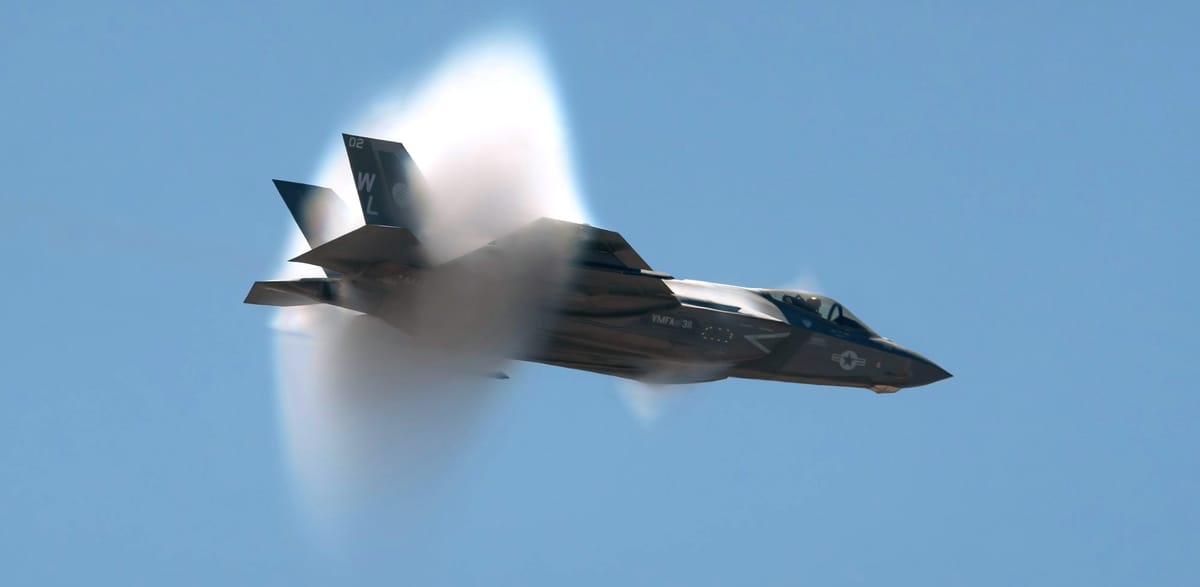Trump sanctions F‑35 sale to Saudi Arabia, NATO airspace tensions rise, Airbus expands Flydubai fleet

TL;DR
- Trump approves F-35 sale to Saudi Arabia, boosting U.S.–Saudi defense cooperation.
- Russia's drone incursions intensify NATO airspace security concerns.
- Airbus seals 150 A321neo deal with Flydubai, diversifying Gulf carrier fleet.
U.S. Approval of a $23 Billion F‑35 Sale to Saudi Arabia: A Strategic and Economic Pivot
Background and Timeline
- 2018 – Murder of journalist Jamal Khashoggi strains U.S.–Saudi ties.
- May 2025 – Riyadh summit yields $142 billion in defense and technology commitments.
- 17 Nov 2025 – President signals support for an F‑35 deal and discusses Saudi participation in the Abraham Accords.
- 18 Nov 2025 – Formal approval of 48 Lockheed Martin F‑35A/B/C aircraft, valued at roughly $23 billion.
Deal Specifics
- Platform: Fifth‑generation F‑35A/B/C stealth fighters.
- Quantity: 48 jets, including training aircraft, spare parts, logistics and pilot training.
- Financing: Combination of direct Saudi government payments and long‑term U.S. defense‑bank financing.
- Delivery: First units scheduled for FY 2027, full operational capability targeted for FY 2030.
Strategic Stakes
The acquisition narrows the qualitative gap between Saudi Arabia and regional rivals, particularly Iran, by embedding advanced stealth, sensor fusion and network‑centric warfare capabilities. From Washington’s perspective, the sale creates leverage for Saudi cooperation on counter‑Iranian operations and reinforces Israel’s qualitative military advantage under the broader Abraham Accords framework. Integration of F‑35 technology also accelerates Saudi indigenous R&D initiatives aligned with Vision 2030.
Economic Tie‑ins
Concurrent to the arms deal, the Saudi sovereign‑wealth fund pledged $600 billion for U.S. data‑center and artificial‑intelligence projects, positioning the F‑35 purchase as a catalyst for deeper tech collaboration. Parallel negotiations cover a small modular reactor program intended to diversify Saudi energy sources, while the broader package seeks to lock Saudi private‑sector investment into the United States.
Risks and Constraints
- Congressional scrutiny may impose stricter end‑use monitoring to prevent technology leakage, especially to China.
- Human‑rights concerns surrounding the Khashoggi case could trigger conditional licensing for future exports.
- Saudi joint naval exercises with China raise the specter of reverse‑engineering sensitive components.
- Enhanced Saudi air power may provoke counter‑measures from Iran and its proxies, affecting regional stability.
Looking Ahead (2025‑2030)
Analysts anticipate an additional $15‑20 billion in follow‑on F‑35 and related weapons sales, contingent on U.S. legislative approval and export‑control compliance. By FY 2028, a joint Saudi‑U.S. development effort on next‑generation unmanned combat aerial vehicles is likely to commence. Policy will continue to balance strategic imperatives with human‑rights considerations, potentially introducing conditional licensing mechanisms to manage the evolving risk landscape.
Russia’s Drone Swarms Are Testing NATO’s Air‑Space Shield
A New Swarm Threat
- In the past month, 152 hostile UAVs entered NATO airspace; roughly three‑quarters were intercepted.
- Four Iskander‑M ballistic missiles were launched toward NATO‑adjacent territory – all downed.
- Incursions touched every eastern flank: Poland’s rail corridor, the Baltic Sea, Norway’s Oslo Airport, and Belgian hubs.
Why NATO’s Defences Are Straining
- Swarm sizes have exploded – from dozens in early 2024 to waves of 200 + UAVs today.
- Low‑RCS Shahed‑type drones saturate conventional radar, forcing reliance on micro‑Doppler and RF‑jamming.
- Hybrid tactics pair drones with ground explosives, threatening logistics chains as seen on Polish rails.
- Current layered air‑defence (Patriot, SAMP‑T) sees interception rates fall from 95 % (2023) to 78 % (2025) for sub‑300‑m UAVs.
What’s Already Being Done
- EU “Drone Wall” – a multi‑layered sensor‑jam‑intercept architecture; pilot in Germany/Poland slated for Q4 2025.
- Belgian‑Latvian deal for 120 Origin Robotics “kamikaze” interceptors, with Phase 1 rollout begun in November 2025.
- UK’s regulatory push for mandatory long‑range C‑UAS capability across critical infrastructure, effective Jan 2026.
- NATO Integrated Air‑Space Surveillance (IASS) – AI‑driven data‑fusion now in Baltic operational testing.
The 12‑Month Forecast
- Swarm size continues upward; NATO kinetic capacity may be outpaced by up to 40 % if not expanded.
- Hybrid sabotage will likely cause logistics downtime of two days or more per event without hardened routes.
- Standardised “Drone Wall” architecture is expected to be adopted alliance‑wide by Q2 2026, boosting interception to > 90 %.
- AI‑enhanced threat classification should cut response latency from 12 seconds to 4 seconds, restoring a > 95 % success rate.
Urgent Steps Forward
- Fast‑track EU‑NATO C‑UAS integration to guarantee interoperable sensors and command links.
- Expand kinetic interceptor stockpiles – add directed‑energy or high‑energy laser platforms for low‑RCS UAVs.
- Harden critical logistics corridors with mobile rapid‑repair teams and autonomous surveillance nodes.
- Prioritise funding for IASS AI modules and conduct joint exercises simulating 200‑UAV swarms.
- Invest in EMP‑type sub‑systems capable of disrupting Russia’s emerging 20 km fiber‑optic drone command links without collateral damage.
Russia’s escalating drone swarms are no longer a sporadic nuisance; they constitute a coordinated, multi‑domain pressure point on NATO’s air‑space and logistics. The alliance’s response must evolve from patchwork fixes to a unified, AI‑driven shield if it hopes to preserve a > 95 % interception rate and keep Europe’s critical arteries open.
flydubai’s A321neo Pivot Signals a New Narrow‑Body Era
Order Overview
- Customer: flydubai (UAE low‑cost carrier)
- Aircraft: Airbus A321neo (with A321LR/XLR options)
- Quantity: 150 jets (announced 18 Nov 2025)
- Estimated value: US $18‑20 bn (list‑price basis)
- Delivery window: 2027‑2032, staggered across five batches
Fleet Dynamics
- Current narrow‑body fleet (2025): 95 Boeing 737 family (≈ 69 MAX, 26 NG)
- Post‑order composition: 150 A321neo added, net increase of 55 aircraft
- Average seat capacity rises from ~160 pax (737‑MAX) to ~210 pax (A321neo), a 30 % uplift per aircraft
- Range extension enables medium‑haul routes (3‑5 h) beyond the existing short‑haul focus
- Engine commonality: CFM‑LEAP‑1A on A321neo complements the LEAP‑1B on flydubai’s 737‑MAX, simplifying training and spares logistics
Market Patterns from the 2025 Dubai Airshow
- Airbus secured three‑digit narrow‑body orders, pushing its backlog above 5 000 units and reinforcing its lead over Boeing in the 150‑seat segment
- Boeing’s counter‑move focused on wide‑bodies, highlighted by Emirates’ 65 Boeing 777‑9 order (US $38 bn) announced 17 Nov 2025
- Gulf carriers are diversifying: Emirates mixes Airbus narrow‑body with Boeing wide‑body, while flydubai adds Airbus narrow‑body to a previously Boeing‑centric fleet
- The A321neo’s higher capacity aligns with a regional trend toward up‑sized narrow‑bodies for marginal medium‑haul markets
Emerging Trends and Implications
- Higher‑capacity narrow‑bodies reduce the need for wide‑bodies on secondary routes, lowering per‑seat cost
- Engine commonality across Airbus and Boeing platforms streamlines maintenance and pilot conversion programs
- Intensified competition in the Gulf market is likely to generate price incentives and accelerated delivery schedules over the next 12‑18 months
- Airbus’s expanding digital ecosystem (e.g., Daejeon tech hub) offers potential upgrades such as AI‑driven flight‑deck tools for flydubai’s new fleet
Projected Fleet Evolution (2026‑2032)
- 2026: 30 A321neo in service; narrow‑body composition shifts to 65 % Airbus
- 2028: 80 A321neo, representing ~50 % of the narrow‑body fleet; Airbus market share reaches 48 %
- 2030: 120 A321neo (~70 % of narrow‑body fleet); Airbus share climbs to 52 %
- 2032: Full delivery of 150 A321neo; Airbus A321 family holds 55 % of the regional narrow‑body market
Strategic Recommendations for flydubai
- Accelerate pilot and crew certification by leveraging LEAP‑1A/1B commonality; target a 12‑month transition window
- Prioritize medium‑haul corridors (e.g., Doha‑Karachi, Dubai‑Bamako) where the A321neo’s 4‑hour range maximizes load factors
- Negotiate bundled digital services—predictive maintenance and flight‑deck upgrades—through Airbus’s Daejeon hub to curb operating expenses
- Structure payment milestones to align with delivery batches, preserving liquidity amid fluctuating oil prices



Comments ()